Introduction to Scottish witch trials
From the 1560s, authorities in Scotland began to seek out and accuse people of performing witchcraft and worshipping the Devil.
Around 2,500 people т mostly women т were executed as witches. Why did this happen?
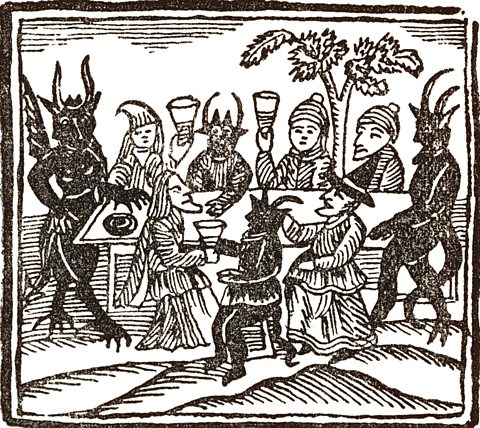 Image source, ALAMY
Image source, ALAMYWhy did people believe in the Devil?
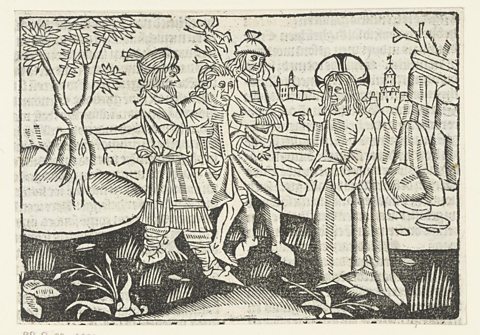 Image source, ALAMY
Image source, ALAMYIn medieval Europe, religion was a huge part of everyone's life.
It was accepted that God was real and could directly affect their day-to-day lives.
It was common that people would describe the good things that happened to them as blessings from God.
People also believed in the Devil and, just as with God, they believed that the Devil could have a very real impact on their lives.
Anything bad or unusual that happened could be evidence that the Devil was active in their homes and communities.
Why did people believe in witchcraft?
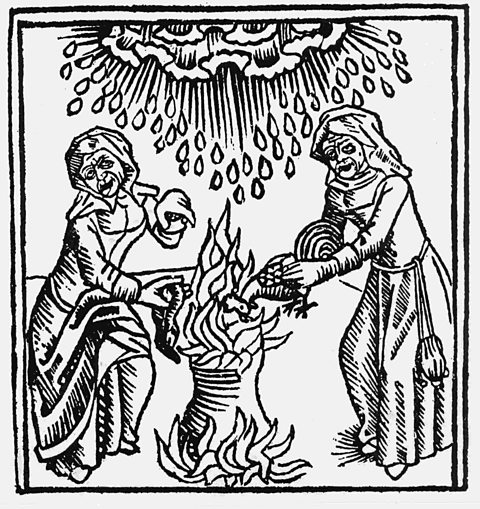 Image source, ALAMY
Image source, ALAMYThere was also a general belief in witches and witchcraft.
Witches were believed to be people who could use magic and spells to influence the world т and people т around them for better or worse.
Not everything was blamed on witches, just those things that were out of the ordinary т such as sudden illness, floods, droughts, and crop failures.
For a long time, there were people who were considered to be witches by their local community.
Witchcraft was seen as Sorry, something went wrongCheck your connection, refresh the page and try again. or a form of superstition.
Up until the 1400s, people suspected of being witches were usually dealt with by the local churches.
Generally, the worst punishment would be that the 'witch' would be shunned by their community.
That changed between around 1450 and 1750.
During this time, across Europe, witches were hunted, arrested, tried and often executed in large numbers.
Different reasons have been put forward for this change in the treatment of witches, including:
- changing Christian beliefs and laws
- religious upheaval
- the harsh effects of a period of climate change
 Image source, ALAMY
Image source, ALAMYDid the church believe in witchcraft?
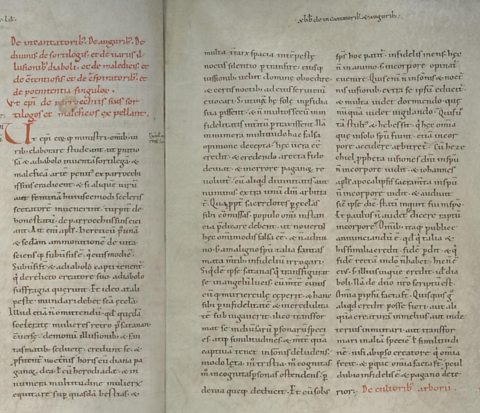 Image source, ALAMY
Image source, ALAMYOne change that led to witch trials across Europe was a change in how the Catholic Church viewed witchcraft.
In the 10th century, the Catholic Church released an official document called the Canon Episcopi.
The document declared that witches were people who had been fooled by the Devil into believing they could perform magic.
Witchcraft had now been linked directly to evil and the Devil, however, the Church, did not believe that witches had real magical abilities.
However, by 1484 the official view had changed.
In that year, Pope Innocent VIII, then the most important and powerful person in Christian Europe, declared that witchcraft was real and those who practised it could do real harm.
The Pope gave powers to local priests and investigators in Germany to seek out and prosecute witches wherever they were found.
 Image source, ALAMY
Image source, ALAMYHow to spot a witch
 Image source, ALAMY
Image source, ALAMYFear of witches began to spread across Europe.
In 1486, Heinrich Kramer wrote a document called the Malleus Maleficarum т or the Hammer of Witches. The document explained how to spot and punish witches.
The document т which said that witches should be executed т was denounced by the church but became very popular all over Europe
Other books and pamphlets were published about witches, and spread quickly due to the new printing presses.
The result was that for people of that period, witchcraft and the Devil were all real problems to be feared.
 Image source, ALAMY
Image source, ALAMYJames VI and witchcraft
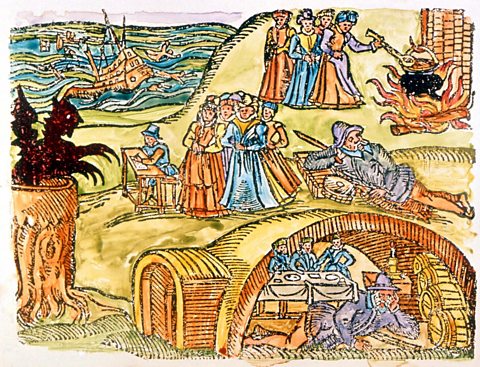 Image source, ALAMY
Image source, ALAMYKing James VI of Scotland, even wrote a book, the Daemonologie, about the dangers of witchcraft after he thought witches had tried to kill him in 1589.
In that year, James had married his Danish bride, Anne. When severe storms almost killed James and Anne as they sailed back from Denmark, James became convinced that witches had been responsible for the storms and that they were an attempt to kill him.
The investigations into the witches suspected of trying to kill James and Anne led to the North Berwick witch trials of 1590.
Witchcraft and the Reformation
 Image source, ALAMY
Image source, ALAMYThe ReformationReligious revolution of the 16th Century which questioned the teachings and authority of the Catholic Church and led to the development of Protestant Christianity. was a period of religious change that swept through Europe in the years after 1517.
Reformers such as Martin Luther in Germany and John Calvin in Switzerland protested against what the Catholic Church taught and how it was run.
These leaders and their protests led to the development of Protestant churches.
The Catholic Church ruled that Protestant beliefs were a crime of heresyReligious belief that is seen to be false or against the official teachings of a church or other religious group..
In countries loyal to the Pope, such as Spain, Portugal, and what is now Italy, Protestants were persecuted and either persuaded (or forced) to convert to Catholicism, excommunicateTo exclude someone. The term comes from the Catholic Church excluding someone from being part in their religious community and receiving the sacrament of communion. or even killed.
Other countries were not so loyal to the Catholic Church. Protestantism was not treated as a crime and was able to spread and grow.
Tension grew between countries as Catholic and Protestant leaders competed for control, often through conflict and warfare.
It also led to countries wanting to become more тGodlyт, or pure, and stamp out anything that might be associated with the Devil.
This meant that it became very important for communities to find and get rid of witches.
 Image source, ALAMY
Image source, ALAMYDo you think religious changes led to witch trials?
What evidence is there to support your opinion?
- Countries where there was more competition between Catholic and Protestant religions, or between different branches of Protestantism, like Germany, Switzerland and Scotland, had a higher proportion of witch trials.
- Countries like Spain, Portugal and Ireland, where there was less religious conflict had fewer witch trials.
but
- Many countries continued to have witch trials long after religious disagreements had been settled.
Witchcraft and climate change
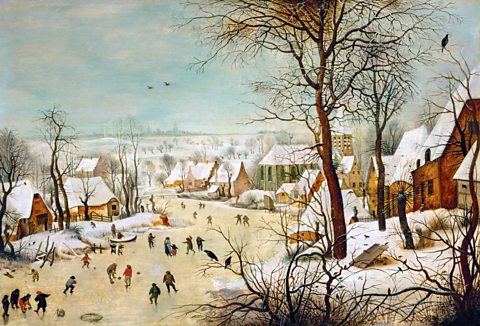 Image source, ALAMY
Image source, ALAMYAround the same time as the witch trials, Europe experienced a period of climate change.
Europeтs climate deteriorated in what is known as the тLittle Ice Ageт.
This led to long periods with more rain and colder temperatures.
There were shorter seasons when food could be grown and sometimes crops failed.
This resulted in hunger and famine, causing much distress across the continent.
Some historians have argued that this increased tensions in communities where there was not enough food to go around, and many wanted someone to blame for the hard times т witches were the easy target.
We can also see witch hunts as having a тsnowball effectт.
When people heard about witches in neighbouring areas, they became more suspicious of witches in their own area, which led to the problem getting bigger and spreading more.
In response to all of this, the era of the witch trials began.
There are different opinions on how long the Little Ice Age lasted. Many researchers say it began in the 1500s and lasted until the middle of the 1800s; others suggest it began around the year 1400 or even earlier.
The main period of European witch trials is often said to last from the late 1400s to the end of the 1700s.
 Image source, ALAMY
Image source, ALAMYDo you think the Little Ice Age was a cause of witch trials?
What evidence is there to support your opinion?
At this time, many people in Europe believed that witches could control the weather, so a period of bad weather and low temperatures would fit with this idea.
The years in which most European witch trials took place are in the same period as the Little Ice Age.
but
- This theory doesn't explain why some countries had many more witch trials than others, for example Scotland had a much smaller population than England, but had more witch trials.
How many people were accused of witchcraft?
Whatever the cause, or causes, across Europe thousands of people were accused of being witches.
It is difficult to know for sure, but many historians estimate that across Europe between 40, 000 and 60, 000 people found guilty of witchcraft were executed.
In Scotland, 3,837 cases of people being accused of witchcraft have been found through historical records.
Records only show the outcome of 305 trials in Scotland. Of these trials, 205 people were executed.
As this is based on just a small number of trials, the number of executions is likely to be much, much higher.
Test your knowledge
More on Scottish witch trials
Find out more by working through a topic
- count2 of 7
